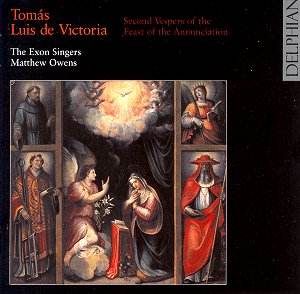In
recent years a number of early music specialists, such as Robert
King and, especially, Paul McCreesh, have issued CDs presenting
music in the context of an often speculative reconstruction
of an historical event or church service. Those I have come
across have struck me as examples of an extremely imaginative
way of shedding fresh light on such music. This Victoria CD
is in some ways similar in conception.
The
scholar Jon Dixon has assembled a number of Marian pieces in
the form of Second Vespers for the Feast of the Annunciation.
This is celebrated on 25 March. First Vespers are celebrated
in the Catholic Church on the evening preceding a Sunday or
major feast while the service of Second Vespers takes place
on the actual Sunday or feast day. In his very interesting booklet
note Dixon says that the collection assembled here is “not intended
as an ‘authentic’ reconstruction, but more as a musical offering
demonstrating how this wonderful body of music could be performed
employing some of the liturgical practices that developed in
the following generation” (after Victoria’s death). I think
his “offering” is extremely successful.
The
Exon Singers is a mixed choir consisting of eight sopranos,
five altos (male and female), five tenors and six basses. The
choir makes a splendid sound and has evidently been prepared
scrupulously by Matthew Owens, their conductor since 1997. Owens
was, at the time of this recording, Organist and Master of the
Music at St. Mary’s Cathedral, Edinburgh
but he has recently moved to a similar post at Wells Cathedral.
On the evidence of this recording he is an expert and inspiring
choral conductor and he gets a committed, enthusiastic response
from his singers.
The
pieces presented here include settings of four Vesper psalms.
The appropriate plainchant antiphon prefaces and concludes each
psalm. However, after the second psalm Jon Dixon has opted not
for the plainchant antiphon but for an eight-part setting of
the same text (Ave Maria). He does the same after the
third psalm, introducing a four-part setting of Ne timeas
Maria. This works very well. Dixon
also incorporates a setting in four parts of the hymn, Ave
maris stella and an eight-part Magnificat. Finally,
as addenda to the Vespers, we hear an eight-part Regina
cœli and a Marian litany also in
eight parts, the Litany of Loreto.
Throughout
the disc the singing of the Exon singers is splendidly confident.
In fact they evince a refreshing enthusiasm, coupled with sensitivity
and expertise. Just occasionally the delivery of the plainchant
may be thought to be a bit too enthusiastic - for example the
antiphon to the second psalm, Laudate pueri (track 3)
– but I’d far rather have that than a over-cautious, constrained
approach. And their open-throated and open-hearted approach
pays many dividends, such as in the thrilling sound of the double
choir in the psalm Nisi Dominus (track 7). Sample also
the uninhibitedly joyful, indeed exuberant performance of Regina
cœli near the end of the proceedings (track 12).
Owens
and his singers are just as successful in more reflective items
such as the beautiful motet, Ave Maria (track 4), heard after
the psalm Laudate pueri. This is quite beautifully sung.
Throughout
the disc all the strands of polyphony come across clearly and
the choir’s diction is excellent. So too is the balance and
the blend of the voices. I’m sure the performers would acknowledge
that they have been well served by the engineers. The recording
is quite full on, presenting the singers with immediacy. This
allows great clarity and detail but there’s ample space around
the sound.
To
complete the attractions of this release the booklet is handsome,
with beautiful colour illustrations on the outer covers. The
notes by Jon Dixon are very good, and full Latin texts and English
translations are provided. Furthermore, the typeface in the
booklet is nice and clear – praise be! – something one can’t
always take for granted.
This
is a distinguished release and a most enjoyable one to which
I’m very happy to give an unreserved welcome.
John Quinn

![]() Exon Singers/Matthew Owens
Exon Singers/Matthew Owens![]() DELPHIAN DCD34025
[68’46”]
DELPHIAN DCD34025
[68’46”] 





